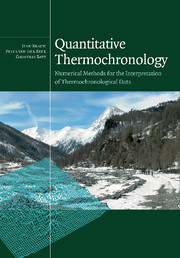Book contents
- Frontmatter
- Contents
- Preface
- 1 Introduction
- 2 Basics of thermochronology: from t–T paths to ages
- 3 Thermochronological systems
- 4 The general heat-transport equation
- 5 Thermal effects of exhumation
- 6 Steady-state two-dimensional heat transport
- 7 General transient solution – the three-dimensional problem
- 8 Inverse methods
- 9 Detrital thermochronology
- 10 Lateral advection of material
- 11 Isostatic response to denudation
- 12 The evolution of passive-margin escarpments
- 13 Thermochronology in active tectonic settings
- Appendix 1 Forward models of fission-track annealing
- Appendix 2 Fortran routines provided with this textbook
- Appendix 3 One-dimensional conductive equilibrium with heat production
- Appendix 4 One-dimensional conductive equilibrium with anomalous conductivity
- Appendix 5 One-dimensional transient conductive heat transport
- Appendix 6 Volume integrals in spherical coordinates
- Appendix 7 The complementary error function
- Appendix 8 Pecube user guide
- Appendix 9 Tutorial solutions
- References
- Index
5 - Thermal effects of exhumation
Published online by Cambridge University Press: 15 December 2009
- Frontmatter
- Contents
- Preface
- 1 Introduction
- 2 Basics of thermochronology: from t–T paths to ages
- 3 Thermochronological systems
- 4 The general heat-transport equation
- 5 Thermal effects of exhumation
- 6 Steady-state two-dimensional heat transport
- 7 General transient solution – the three-dimensional problem
- 8 Inverse methods
- 9 Detrital thermochronology
- 10 Lateral advection of material
- 11 Isostatic response to denudation
- 12 The evolution of passive-margin escarpments
- 13 Thermochronology in active tectonic settings
- Appendix 1 Forward models of fission-track annealing
- Appendix 2 Fortran routines provided with this textbook
- Appendix 3 One-dimensional conductive equilibrium with heat production
- Appendix 4 One-dimensional conductive equilibrium with anomalous conductivity
- Appendix 5 One-dimensional transient conductive heat transport
- Appendix 6 Volume integrals in spherical coordinates
- Appendix 7 The complementary error function
- Appendix 8 Pecube user guide
- Appendix 9 Tutorial solutions
- References
- Index
Summary
In our quest to extract information on exhumation from thermochronological data, we now turn our attention to the effects that exhumation itself, i.e. the advection of rocks towards the Earth's surface, may have on the temperature structure of the crust. It is important to realise that the process that we are trying to quantify, namely rock exhumation, is strongly non-linear: it perturbs the system that we propose to use to measure it, i.e. the temperature history of the rock.
Steady-state solution
We first provide a means of determining the perturbation caused by advection under the assumption of steady-state exhumation, i.e. for situations in which rock uplift is balanced by erosion over a long period of time. Although this is an idealised scenario, it is worth considering, in order to assess the magnitude of the perturbation and the conditions under which it is likely to be significant. Furthermore, thermal steady state is not an unlikely scenario when considered on the scale of an entire, mature orogen, such as in the Southern Alps of New Zealand or in the Taiwan orogen (Willett and Brandon, 2002).
Uplift and exhumation
As already mentioned in Section 1.2, it is very important always to keep in mind that the cooling that is documented by thermochronology during exhumation is related to the advection of rocks towards the cold upper surface of the Earth.
- Type
- Chapter
- Information
- Quantitative ThermochronologyNumerical Methods for the Interpretation of Thermochronological Data, pp. 76 - 104Publisher: Cambridge University PressPrint publication year: 2006
- 1
- Cited by



